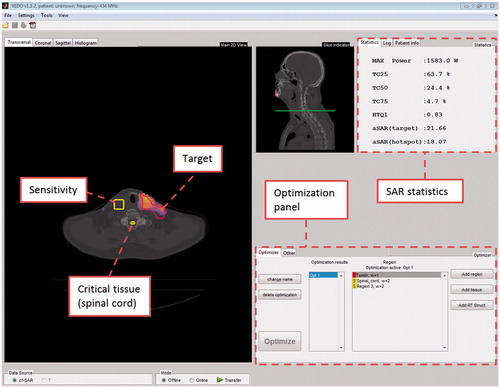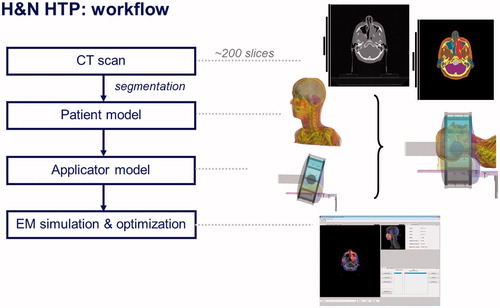Figures & data
Figure 2. Layout of VEDO. CF SAR is overlaid on the CT-scan, the lighter the colour the higher the CF SAR.

Figure 4. [Case 1] Frontal and sagittal view of the patient. For clarity, only segmented bone and CTV are shown. Blue probes (N1,N4) are probes outside the CTV, green probes (T2,T3) are within the CTV and are used to partly base our steering actions on.
![Figure 4. [Case 1] Frontal and sagittal view of the patient. For clarity, only segmented bone and CTV are shown. Blue probes (N1,N4) are probes outside the CTV, green probes (T2,T3) are within the CTV and are used to partly base our steering actions on.](/cms/asset/ec1c9f3e-1d79-4179-8b3e-75734ee18c54/ihyt_a_783934_f0004_b.jpg)
Figure 6. [Case 1] Mean SAR in the CTV based on the recorded applied powers and phases during treatment. The SARtarget values are sampled just before each change of optimisation setting and at the end of treatment.
![Figure 6. [Case 1] Mean SAR in the CTV based on the recorded applied powers and phases during treatment. The SARtarget values are sampled just before each change of optimisation setting and at the end of treatment.](/cms/asset/e8043a47-df86-4ad1-a298-040fa7bed5ab/ihyt_a_783934_f0006_b.jpg)
Figure 7. [Case 2] Patient during the test treatment. The HYPERcollar was originally designed to treat only patients with a tumour in the neck. For patients with a tumour in the head, we use sticky tape for comfort and respiration purposes.
![Figure 7. [Case 2] Patient during the test treatment. The HYPERcollar was originally designed to treat only patients with a tumour in the neck. For patients with a tumour in the head, we use sticky tape for comfort and respiration purposes.](/cms/asset/67b972a6-eddf-41e7-8953-7752d0b5d184/ihyt_a_783934_f0007_b.jpg)
Figure 8. [Case 2] Frontal and sagittal view of the patient. For clarity, only segmented bone and CTV are shown and only the probes within the CTV are labelled. Blue probes are probes outside the CTV, green probes (T1, T2 and T3) are within the CTV and are used to partly base our steering actions on.
![Figure 8. [Case 2] Frontal and sagittal view of the patient. For clarity, only segmented bone and CTV are shown and only the probes within the CTV are labelled. Blue probes are probes outside the CTV, green probes (T1, T2 and T3) are within the CTV and are used to partly base our steering actions on.](/cms/asset/b5fe7273-0d4c-4f5b-969a-ca80d17956e7/ihyt_a_783934_f0008_b.jpg)

![Figure 3. [Case 1] Patient in the HYPERcollar during the test treatment.](/cms/asset/ecbc343e-bb0e-4095-8e15-98223245e50b/ihyt_a_783934_f0003_b.jpg)
![Figure 5. [Case 1] Optimisation settings and its properties.](/cms/asset/2c2cc9b9-17a2-4ed1-b3a3-41484c7c7f90/ihyt_a_783934_f0005_b.jpg)
![Figure 9. [Case 2] Optimisation settings and its properties.](/cms/asset/ff0f9a65-ff1b-4ff7-8c9c-5fe65d062ae4/ihyt_a_783934_f0009_b.jpg)
![Figure 10. [Case 2] Mean SAR in the CTV based on the recorded applied powers and phases during treatment. The SARtarget values are sampled just before each change of optimisation setting and at the end of treatment.](/cms/asset/324f876c-21f0-411a-96ea-cfdabd2cabfd/ihyt_a_783934_f0010_b.jpg)